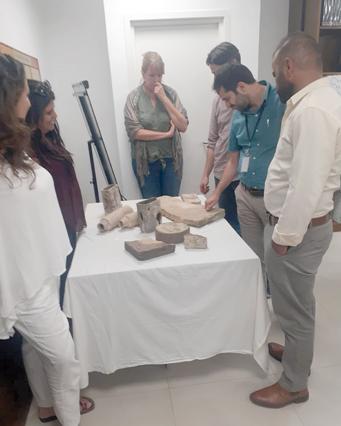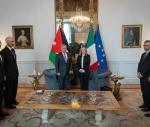You are here
Database project encourages collaboration in Levantine ceramics research
By Saeb Rawashdeh - Oct 08,2022 - Last updated at Oct 09,2022

Remains of the bowl from Petra, around 150 AD-200AD (Photo courtesy of the LCP)
AMMAN — The Levantine Ceramics Project (LCP) is the brainchild of Boston University ceramic specialist Professor Andrea Berlin, who developed LCP as a way to connect scholars specialised in the archaeology and history of the Levant.
“The LCP [https://www.levantineceramics.org/] is a project of the American Society of Overseas Research that was started to facilitate research by helping archaeologists working on ceramics from the Neolithic to the Ottoman period throughout the Levant to cooperate and share information. It is now also run and maintained by several editors from each country in the Levant,” said Assistant Professor from University of Warsaw Micaela Sinibaldi.
The study of ceramics is important for the LCP, since ceramics bear clues and signs for a range of historical activities, behaviours, and ideas.
“Scholars working on ceramics from the Levant are very interested in what other researchers discover and study on the subject, in what are today different countries, because ceramics often travelled around. Such information is necessary for conducting research”, she said.
The project consists of a large database of information on ceramics, as well as “workshops which are regularly organised in different countries, where we have the opportunity to meet other scholars in person, present on and discuss new materials added to the database and talk about ways to move ahead with the project in the future,” according to Sinibaldi.
“We recently had a workshop in Amman at the beginning of August, hosted by the American Centre of Research, where we presented and discussed ceramics from Jordan from the Iron Age to the Ottoman period,” Sinibaldi said.
“The website is also a very useful tool for scholars working in the same region, not only to find parallels, but also to understand and better describe each ware through discussions,” said Sinibaldi, adding that she joined the LCP after being invited to contribute to one of the workshops.
“What persuaded me to join the project was how publishing information about ceramics online offers an opportunity to exchange more information of a higher quality than in print,” she added.
She noted that, for example, “we can publish and view a large quantity of colour images of ceramics, including of petrographic samples, showing the fabrics of the ceramics analysed. This is rarely possible in printed publications that have restrictions on the number of images, since they are expensive”.
The other advantage is that online information becomes accessible much faster than through a printed publication, Sinibaldi said. Interactive maps are also available through the project, allowing searches by area, ware, chronology, or even workshops and sites.
Definitions and bibliographies can also be uploaded – another very useful tool. Moreover, the database accepts both published and unpublished data; all information uploaded to the database is open access, allowing anybody to consult the information. The future of publications is moving towards an integration of printed material with open access data, Sinibaldi highlighted.
“Personally, my work focuses on ceramics of the Middle and Late Islamic periods from Jordan, in particular handmade pottery, a group of ceramics largely dominant at most sites in Jordan from the Mediaeval and Ottoman periods but which is still in a relatively early stage of study, though research is progressing fast,” Sinibaldi said, adding that more of the project’s workshops will be organised across the region, including Jordan.
Related Articles
AMMAN — To increase understanding of Jordan’s archaeological heritage, two archaeologists, Jihad Haron and Douglas Clark, introduced a manua
AMMAN — A Danish-German project is attempting to address the problem of poorly-documented mediaeval material found at sites like Jerash with
AMMAN — The Islamic Beidha Project was launched in 2014, under the direction of Italian archaeologist Micaela Sinibaldi, to conduct excavati

















